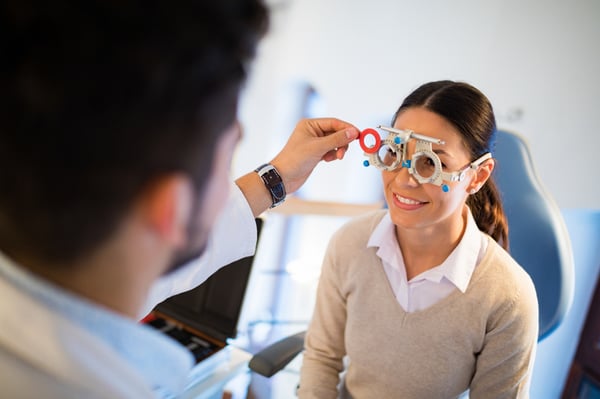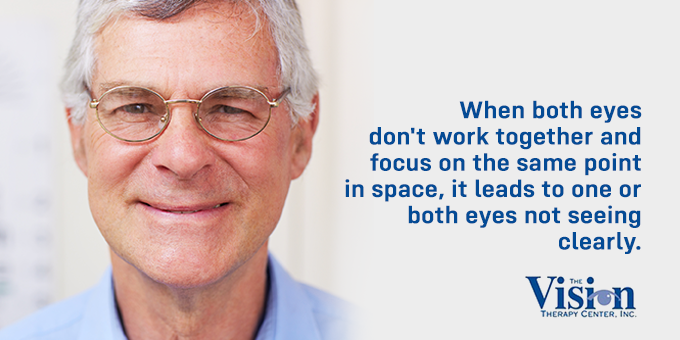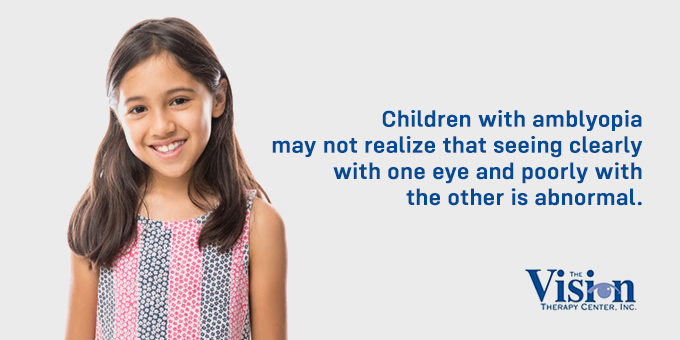
We field inquiries literally from all over the world regarding lazy eye treatment for adults. The question is always the same: Am I too old to get treatment for my lazy eye?
Our answer is always the same: People of all ages, including adults, can be treated for amblyopia, commonly referred to as “lazy eye.”
For some, this is shocking news. That’s because there’s been a pervasive and long-held misconception in the general public, and even the scientific and medical communities, that anyone older than eight can’t be treated effectively for lazy eye.
As developmental optometrists, we’re here to tell you that this generalization is just not accurate. It is possible for adults to be treated for lazy eye.
What is Lazy Eye?
Lazy eye is the non-scientific term for amblyopia. The condition results from the poor development of eye teaming. This is a crucial functional vision skill that enables both eyes to work together and focus on the same point in space. When they don’t, it leads to one or both eyes not seeing clearly.

Moreover, because the brain doesn’t develop the ability to see clearly in one or both eyes, the eyesight of a person with amblyopia cannot be improved with glasses alone.
Many people tend to confuse “lazy eye” with an eye turn (sometimes called “crossed eyes”). This typically occurs when one eye focuses on an object while the other points in another direction.
An eye turn is actually a separate condition called “strabismus.” A person may have amblyopia with or without an eye turn, a fact which is explained on our amblyopia webpage.
What Causes Lazy Eye?
In most cases of amblyopia, one eye just isn’t seeing as clearly as the other.
But why? Due to high degrees of nearsightedness, farsightedness, astigmatism, and/or the presence of a constant eye turn, the brain has suppressed (or turned off) the information in one eye. This negatively impacts the development of clear vision.
Normally, the brain receives two images at slightly different angles, and it combines them to produce a 3D image. This is called binocular vision. But that’s not the case with amblyopia.
The suppression of information from one eye negatively impacts the development of binocular vision. As a result, it seems like one eye does all the work of seeing. Thus, the other eye is characterized as “lazy.”
Why the Misconception About Lazy Eye Correction for Adults?
Amblyopia in adults can be treated, often through a combination of prescription lenses, vision therapy and sometimes patching. More on that below. But first, let’s address the misconception that treatment can only work with young children. Why do so many believe this?
In her book Fixing My Gaze, neuroscientist Sue Barry notes that since the mid-1990s, “scientific and medical communities have cited strabismus and a related disorder called amblyopia as classic examples of developmental disorders that cause permanent changes in vision if they are not corrected in a critical period in early life.”

The reason for this misunderstanding, says Barry, can likely be tied to misinterpreting the research conducted by Torsten Wiesel and David Hubel at Harvard Medical School.
They simulated deprivation amblyopia by depriving kittens the use of one eye. This led to their discovery that the brain will ignore signals from an improperly functioning eye and use only the image from the properly functioning eye.
Unfortunately, the research has been extrapolated—and misinterpreted—by many physicians to mean that once vision has developed within a critical period in childhood, visual skills become fixed and cannot be improved.
Further Research Proves The Idea Wrong
Recent research tells us a different story. We now know that the circuitry of the brain can actually change at any age as a result of our actions and experiences.

For example, a study funded by the National Eye Institute (NEI) showed that children ages 7 to 17 years experienced improvement when treated for amblyopia.
So Can Lazy Eye be Corrected in Adults?
The answer is yes. But why?
Regardless of a person’s age, the visual system -- which consists of the eyes, the brain and the visual pathways -- can be retrained due to the brain’s plasticity.
More specifically, for amblyopia the visual skill that needs to be retrained is the aforementioned binocular vision.
Remember, poor binocular vision is the root cause behind amblyopia. Healthy binocular vision is when both eyes see similarly and the brain can easily combine the images. With poor binocular vision, the two images cannot be combined into one single image and one image is ignored.
But because of brain plasticity, this doesn’t have to be a permanent state. And therein lies the key.
Without a doubt, treatment is most effective when it’s administered at an early age. Generally speaking, the plasticity of the brain decreases as a person ages.
However, it is still possible at any age to retrain the visual system, restore binocular vision, and correct amblyopia.
In a video overview of this post, we review why the visual system needs to be retrained.
Lazy Eye in Adults: Symptoms
Amblyopia can be difficult to detect because there are no cosmetic indications. (With strabismus, for example, the eyes may be crossed, or one turned outward or inward.)
Also, children with the condition often don’t realize that seeing clearly with one eye and poorly with the other is abnormal. This is why it’s possible to carry the condition untreated into adulthood.

Though amblyopia doesn’t have physical signs, it does have telltale symptoms, which can include:
- Difficulty with depth perception
- Eye strain
- Visual fatigue
- Headaches
Some of these symptoms result in clumsiness or difficulty in activities like throwing or catching an object. An adult may bump into objects or may experience issues while driving and judging distances.
The only way to truly determine if someone has amblyopia is through a functional vision exam. A functional vision exam includes a comprehensive assessment of visual information processing, binocular function and other visual skills.
How to Fix a Lazy Eye in Adults: Treatment
Amblyopia (lazy eye) in adults can be treated through three approaches. Note that one or all of these may be required. Ultimately, it will depend upon the individual diagnosis.
- Vision therapy. Vision therapy is a series of exercises and activities that help a person improve their visual skills. In the case of amblyopia, vision therapy helps develop a person’s binocular vision. This is the most effective treatment as it addresses the root cause of amblyopia.
- Glasses. Prescription lenses may be prescribed to help improve binocular vision. As we’ve noted in a previous post, the right lens prescription is critical, as it’s important to have a prescription that encourages binocular vision.
- Eye patching. In some cases, forcing the weaker eye to work by blocking or fogging the favored eye with special lenses, an eye patch, or eye drops may be prescribed.
Are There Lazy Eye Exercises for Adults?
As part of a program of optometric vision therapy, activities and exercises to improve binocular vision are prescribed. However, we caution adults about online programs that promise miracle cures for amblyopia through lazy eye exercises.
The best treatment for the condition is an individualized program of optometric vision therapy overseen by a developmental optometrist.
How Much Does it Cost to Fix a Lazy Eye?
The total costs of treatment for a lazy eye will vary, depending on the severity of the condition and insurance coverage. Most vision therapy programs last 6-9 months. You can learn about vision therapy costs here.
Is There a Surgery for Adults With Amblyopia?
There is no surgical procedure for amblyopia.
Recovering from Adult Lazy Eye: Take the Next Step
Depending on the level of severity of the amblyopia, it can take considerable time to treat. Remember, the process is reversing a lifetime of suppression.
While it's possible to improve in adults, amblyopia treatment requires motivation and commitment as it typically takes longer to treat than in children.
The good news for adults with amblyopia is that there is definitely a possibility for improved vision. But there are no guarantees. Every case is different, and every patient must be thoroughly evaluated through a Functional Vision Test.
We strongly encourage you to visit a developmental optometrist and see if treatment is possible for you. If you live in or near Wisconsin, contact The Vision Therapy Center. If you live outside Wisconsin and/or the United States, this article can provide you with links to developmental optometrists all over the world.


